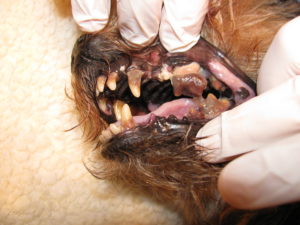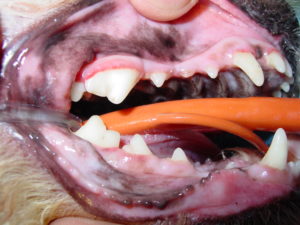When was the last time you had a good look in your dog’s mouth? If he’s over three years old, there is a 75 percent chance that he has dental disease—plaque, tartar, and inflamed gums. However, besides causing bad breath and tooth loss, the infection in the oral cavity can spread to vital internal organs.
Small breed dogs are prone to tartar accumulation at very young ages. The result is they lose many teeth by the time they are 10 years old. It all begins with the formation of a thin, soft film of plaque (food and bacteria) on the teeth. Left undisturbed, plaque eventually mineralizes and hardens to form tartar.

Teeth before cleaning
Meanwhile, the bacteria in the mouth cause inflammation of the gums (gingivitis) and recession of the gum-tooth attachment. A healthy sulcus—the natural depression in the gum next to the tooth—is at most a few millimeters deep. In dogs with severe gingivitis, gum attachments can break down to depths as great as 15 millimeters. As the gum recedes, there is a corresponding breakdown of supporting bone. The tooth becomes abscessed and falls out.
A small incisor that has just one root is lost very quickly when it’s abscessed because it has so little holding it in place. In contrast, a large carnassial tooth such as the upper fourth premolar (fourth tooth behind the upper canine tooth) has three roots. It takes much longer to fall out. Each of the roots must become loose before the tooth is released from its socket.
Larger breed dogs such as German Shepherds don’t collect as much tartar on their teeth so they are not as prone to gum recession. Though they can have problems with gingivitis and tartar, they are much more prone to tooth fracture. The tooth most commonly damaged is the upper fourth premolar (PM4).
When the outer surface of PM4 is cleaved off, the pulp cavity is exposed. Ultimately, bacteria invade and travel up to the end of each root, creating an abscess. This pus pocket causes significant pain.
Whether a dog has an abscessed fractured tooth or tartar and gum disease, the bacteria in his mouth can penetrate his gums and migrate via the bloodstream throughout his body—the heart, kidneys, and liver are particularly prone to invasion by oral bacteria.
In the heart, bacteria readily settle on the delicate valves, causing scarring that leads to valvular leakage. Eventually, dogs with leaky valves develop congestive heart failure—an inability of the heart to pump enough blood forward.
When bacteria land in the kidneys, they stimulate the formation of tiny abscesses which cause deterioration of kidney function. Over time, these changes result in chronic renal failure.
Many dogs with dental disease have elevated liver enzymes. In this case, the bacteria have migrated to the liver, causing infection and tissue damage.

Teeth after cleaning
How can you help your canine friend live a longer life? Look in his mouth regularly. If you can see his gums are cherry red, he has gingivitis. If you can smell foul breath, he has a bacterial infection—it might just be from plaque, but it could be from an abscessed tooth.
Something to remember is that it is difficult to assess your dog for oral pain. In rare circumstances, you will notice that he refuses a hard treat or that he chews on one side. In most cases, dental pain goes undetected. It isn’t until a problem tooth is removed and dogs experience increased vitality that an owner recognizes the agony their dog has been in.
When you detect a problem in your dog’s mouth, have him examined by your veterinarian. If he has minimal gum recession, a proper cleaning both above and below the gum line can help the gum re-attach. If you wait too long, the pockets become deeper (more than three millimeters), the roots become exposed, and tooth loss becomes an inevitable fact.
Oral disease can shorten your dog’s life. Veterinarians see the consequences of mouth infections daily—abscessed teeth, gingivitis, as well as weak hearts, failing kidneys, and stressed livers. Don’t ignore bad breath, discolored teeth, or red gums in your canine friend. Your dog needs diligent oral care from both you and your veterinarian to live a full and healthy life.
How We Clean Teeth
- Remove gross tartar.
- Remove tartar under the gums.
- Polish the teeth.
- Probe pockets and search for cavities.
- Flush out pockets with saline or cleansing solution.
Dr. Louise Janes D.V.M. & Dr. Jeff Grognet D.V.M.
 Mid-Isle Veterinary Hospital
Mid-Isle Veterinary Hospital
5-161 Fern Road West
Qualicum Beach, BC
Tel (250) 752-896
Mid-Isle Veterinary Hospital
See all articles by Dr. Louise Janes D.V.M. & Dr. Jeff Grognet D.V.M.



